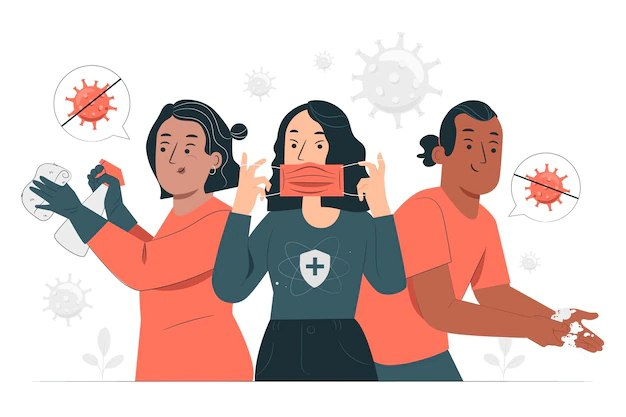Is tiredness a symptom of COVID?



Tiredness/fatigue is the subjective feeling of being physically and mentally tired, sluggish, lacking energy, and worn out. You may find it difficult to do even your normal chores. It is one of the most common symptoms of several systemic, neurological, and psychiatric syndromes, but the exact cause cannot be found in many patients.
It can also result from simple lifestyle choices such as not getting enough sleep, having an unhealthy diet, using alcohol or drugs, and not exercising regularly. These lifestyle decisions can lead to a decrease in energy levels, resulting in fatigue.
The medical conditions that can cause fatigue include anaemia, arthritis, infections (COVID-19, flu), hypothyroidism, hyperthyroidism, sleep difficulties, congestive heart failure, cancer, diabetes, and kidney and liver disease. Mental disorders, such as anxiety and depression, can also cause fatigue. Recognising the potential causes of fatigue is essential to seek the appropriate treatment.
If you experience fatigue that you can't attribute to a known cause, such as lack of sleep or alcohol, it could indicate a medical issue. In this case, it is vital to seek medical advice. Various tests can diagnose the cause of your symptoms, including at-home tests that are readily available. Click here
Anaemia: is when the number of red blood cells or the amount of haemoglobin in the blood drops below what is normal for a healthy person. The common symptoms associated with anaemia include tiredness/ fatigue, chest pain, shortness of breath, rapid or irregular heartbeat, cold hands or feet, headache, dizziness or fainting, paleness, jaundice, and dry or easily bruised skin.
Various factors can cause anaemia, but the most common cause is iron deficiency anaemia. Iron is essential to haemoglobin and myoglobin, and iron deficiency can lead to anaemia. Fortunately, this type of anaemia can be easily reversed with iron supplements.
Psychiatric Disease: Fatigue is a common physical symptom associated with many primary mental health conditions, such as depression, anxiety disorders and sleep problems. Research shows that more than three-quarters of patients with unexplained chronic fatigue report psychiatric symptoms.
Endocrine Disorders: Fatigue is a common symptom of endocrine disorders.
Hypothyroidism can cause fatigue associated with hair loss, dry skin, cold intolerance, constipation, and weight gain.
Hyperthyroidism is associated with fatigue, heat intolerance, sweating, and palpitations.
Adrenal insufficiency can also cause unexplained fatigue, often with loss of appetite, weight loss, nausea, myalgias, and arthralgias.
Chronic liver failure and chronic kidney disease can both cause fatigue. This symptom is especially prevalent in hemodialysis patients, with over 80% reporting fatigue. It is one of the most commonly reported symptoms among those with chronic kidney disease.

Drugs: can have a significant impact on fatigue. Many medications, drugs, drug withdrawal, and chronic alcohol use can all lead to fatigue. Common medications more likely to cause fatigue include antidepressants, antipsychotics, and anxiolytics. Sometimes, these medications can even cause fatigue as a side effect. It is essential to talk to a doctor before stopping any medications to ensure that the fatigue is not being caused by the drugs and that the patient is not at risk of any other health complications.
Infection: this is a common cause of fatigue, both acute and chronic, and can be a bacterial or viral infection. When suffering from unexplained fatigue, mainly if it is prolonged or chronic, it is essential to evaluate for any undiagnosed disorders that may be the underlying cause. It is crucial to identify and treat any underlying conditions in order to reduce fatigue and improve overall health.
Cardiovascular and Pulmonary Diseases: Fatigue is one of the most common symptoms reported by patients with congestive heart failure and chronic obstructive pulmonary disease. This symptom significantly negatively impacts the quality of life of those affected by it. It can cause feelings of exhaustion and fatigue, making it difficult for individuals to perform everyday tasks. Furthermore, it can lead to a decrease in physical activity, further exacerbating the issue. As such, it is vital to recognise and treat this symptom to improve the quality of life of those affected.
Malignancy: When cancer fatigue is accompanied by weight loss that can't be explained, it can be a sign of cancer that hasn't been found yet. However, it is rare for cancer to be identified if you have unexplained chronic extreme tiredness without other signs or symptoms. So, it's essential to pay attention to any other signs and symptoms that may be present so that any possible underlying conditions can be correctly diagnosed.
Since its discovery in late December 2019, the SARS-CoV2 or Covid virus, which belongs to the coronavirus family, has been responsible for causing COVID-19, an infectious disease mainly affecting our lungs.
WHO declared the disease a global public health emergency in January 2020 because it spread quickly. By March 2020, it had become so widespread that it was reported as a pandemic. This was much sooner than expected, highlighting the need for global collaboration to contain the virus.
The COVID-19 virus can be easily killed by commonly used disinfectants like alcohol and sanitisers. It's true! That's why it's so important to keep your hands clean and use these products to help prevent the spread of the virus. So make sure you keep your hands clean and use the proper disinfectants to keep yourself and others safe!

The virus is believed to be spread in a variety of ways! You can catch it by simply being in the same room as an infected person who sneezes, coughs, shakes, or touches hands with them. It can also spread through contact with an infected object or surface. Infected people are typically contagious for ten days and can still spread the virus even when not showing symptoms. So be sure to keep your distance and wash your hands often!
The transmission of the virus has been incredibly high, and many countries have sadly lost many lives to it. Many countries declared a quarantine to help keep their people safe, where everyone was expected to stay at home and report any symptoms they were experiencing. This allows those who are ill to receive the proper treatment promptly. That way, anyone who needed medical attention could get it right away! It's a great way to stay safe and healthy. Other recommended preventive measures are wearing protective masks, social distancing, and creating a more ventilated environment.
COVID symptoms can be tricky - they can range from very mild and easily missed to severe and even deadly. It's essential to be aware of the signs and symptoms, so you can take the necessary steps to protect yourself and those around you.
Even if tiredness is the most commonly reported symptom, it is not the only symptom that COVID-19 infection manifests as. Some other common symptoms include:
Fever
Dry cough
Myalgia
Headache
Sore throat
Loss of smell or taste
runny nose/sneezing, and
general unwell feeling
And other symptoms as the infection progresses
Chest pain
Difficulty of breathing
Respiratory distress
Reduced oxygen saturation in the blood
Having comorbid conditions like diabetes, liver or kidney disease, cardiovascular disease, and immunocompromised conditions like HIV/AIDS and cancer can worsen the progression of the infection.
The risk is also increased for both the elderly and young people and pregnant women. Taking extra precautions if you fall into any of these categories is essential.
If you're feeling any symptoms of COVID-19, such as extreme tiredness, it's essential to take a test to find out if you're infected. There are tests available, so grab one if you're feeling unwell. If you test positive, it's important to isolate yourself and take special care of yourself.
If you experience more severe symptoms, you must visit a nearby hospital for the necessary management. To stop the virus from getting around, it's vital to quarantine for up to two weeks if you start showing any symptoms of COVID-19.
Antigen testing and nucleic acid amplification tests (NAATs) are the primary categories of viral diagnostics.
Depending on the situation's specifics, one type of test might be advised more. These tests involve the examination of samples taken from the mouth or nose. Through the analysis of these samples, a diagnosis can be made to determine if a virus is present.
Nucleic Acid Amplified Tests are similar to PCR-based tests, are typically administered in a laboratory, and are frequently the most reliable testing for detecting COVID infection. After a positive test result, viral genetic material can stay in the body for up to ninety days. Therefore, if you have tested positive within the past 90 days, you should not utilise a NAAT.
Antigen testing: findings can be acquired within 15 to 30 minutes, which is considered quick. However, they are not as reliable as NAATs, particularly in the absence of symptoms. A single negative antigen test cannot conclusively demonstrate the lack of infection; therefore, it is advised that a negative antigen test be performed at least twice, with at least 48 hours between each attempt.
Self-tests, also known as "at-home testing," are often antigen tests that can be performed anywhere. Thus there is no need to travel to a specific location to take them. These tests are also known as "do-it-yourself" tests. Remember that the recommendations provided by the FDA and the manufacturer, which may advise how frequently you should test, should be followed. If you get multiple tests that all come back negative, it increases the likelihood that the virus that causes COVID-19 is not present in your body.

It's incredible to think that after so many trials and tests, COVID-19 vaccines have been approved and distributed since December 2020! We now have a range of new vaccines to help strengthen our immune systems and fight off viruses, and they are being distributed and used in many countries, including developing ones.
Some of the most popular vaccines include AstraZeneca Vaxzevria, Moderna Spikevax, Pfizer/BioNTech, Janssen Jcovden (Johnson & Johnson), Medicago covifenz, and Novavax. In the UK, the first three vaccines are being used, so ensure you get vaccinated soon if you haven't done it already.
According to the most recent report by the government of the UK on their official K government website for data and insights on coronavirus, which was revised on December 2022, about 79.9% of the population have at least received the first dose of the vaccine, and about 75.4% are fully vaccinated. This is a massive step in the right direction, and we can only hope that the numbers continue to rise.
Since its development, the Covid vaccination has had various adverse consequences. Local side effects, such as pain, inflammation, and swelling at the injection site, are among the vaccine's most often reported adverse effects. Systemic adverse effects, such as fever, shivering, tiredness or fatigue, and nausea, can also occur. It is important to note that you cannot get Covid from the vaccine. Suppose your symptoms last more than three days, and you develop a cough, sore throat, loss of smell and taste, or any other symptoms of Covid. In that case, you should get tested for possible Covid infection that you may have acquired before getting vaccinated and put in quarantine.
If you have experienced any of the side effects mentioned above, you can report them to the government of the United Kingdom by using this link. This will help ensure that the government is aware of any potential issues and can take the necessary steps to address them.
The coronavirus pandemic has enormously impacted global health and economics. No country was fully prepared to handle the challenges posed by this virus. Some countries have been hit harder than others, devastatingly affecting their health systems and economies. But all countries are feeling the effects of this pandemic, and we all must work together to find solutions to help everyone get through this difficult time.
Extreme tiredness/Fatigue is a symptom that can be caused by a wide variety of conditions, ranging from something as simple as not getting enough sleep to more serious medical illnesses, such as acute illnesses like COVID-19 and the flu or chronic illnesses like anaemia, kidney and liver disease. Because of this, we mustn't dismiss or disregard this symptom if it continues for a considerable time. Available tests to test for the possible case of tiredness can be found here.
There are several things that we can do to help ourselves feel better, such as consuming sufficient amounts of water, eating a healthy diet, engaging in regular physical activity, obtaining adequate amounts of sleep, engaging in relaxing activities like yoga, and avoiding the use of alcohol, tobacco, and any other illegal drugs. Taking these measures can guarantee that we continue to enjoy good health and a high level of vitality. You should visit a healthcare professional if you are still experiencing fatigue even with these measures.










Plus get the inside scoop on our latest content and updates in our monthly newsletter.